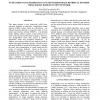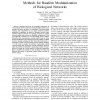269 search results - page 11 / 54 » A Minimax Method for Learning Functional Networks |
IWANN
1999
Springer
13 years 12 months ago
1999
Springer
To avoid the curse of dimensionality, function approximators are used in reinforcement learning to learn value functions for individual states. In order to make better use of comp...
ICMCS
2005
IEEE
14 years 1 months ago
2005
IEEE
This paper presents a new framework called fuzzy relevance feedback in interactive content-based image retrieval (CBIR) systems based on soft-decision. An efficient learning appro...
TNN
2008
13 years 7 months ago
2008
In this paper, a general method for the numerical solution of maximum-likelihood estimation (MLE) problems is presented; it adopts the deterministic learning (DL) approach to find ...
ESANN
2004
13 years 9 months ago
2004
Standard pattern recognition provides effective and noise-tolerant tools for machine learning tasks; however, most approaches only deal with real vectors of a finite and fixed dime...
BIBE
2006
IEEE
14 years 1 months ago
2006
IEEE
— Biological networks are formalized summaries of our knowledge about interactions among biological system components, like genes, proteins, or metabolites. From their global top...


